When do you use shear scraping vs a negative rake scraper?
What top angle do you favor on a negative rake scraper?
What top angle do you favor on a negative rake scraper?
If your scraper is too aggressive, you are not using it correctly. The back of the handle must be higher than the cutting burr. Drop the handle too much and it will self feed. Keep the handle up and it will make the same whisker fine curls as a negative rake.I use D-way NRS’s. They have 20 degrees on the top angle and 70 on the lower angle. I prefer the NRS’s over conventional scrapers. They are less aggressive. I like to shear scrape on the outside of the bowls and NR scrape on the inside.
I turned for over 35 years before anyone "invented" the current negative rake scraper. I bought a negative rake scraper, and now it's in my misfit, unused tool drawer. Most of us used the Irish grind bowl gouge, skew, or freshly ground scraper to do fine scraping in the past. I still think a fine burr on a big scraper is a better tool. A negative rake scraper is NOT a necessity. It is a great way to spend money if that is your goal.
When do you use shear scraping vs a negative rake scraper?
What top angle do you favor on a negative rake scraper?
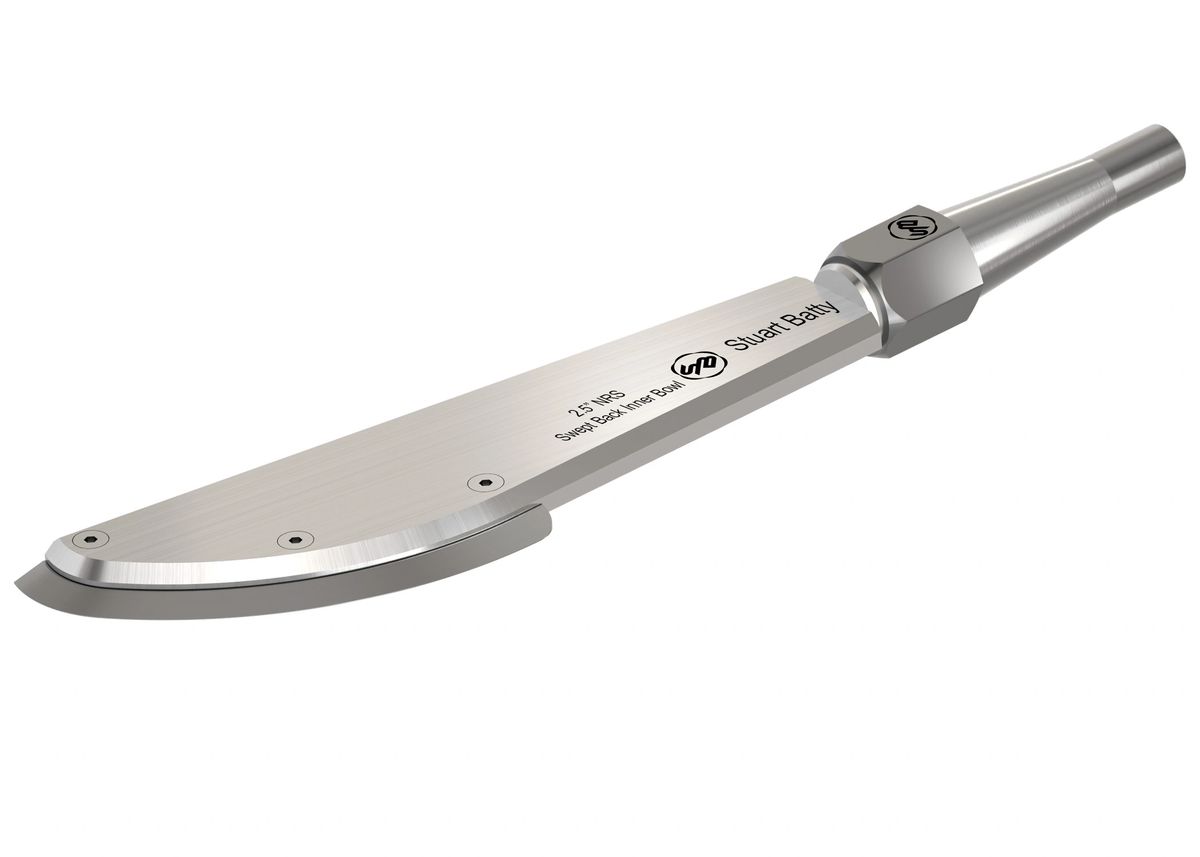
Unless you're working on the INSIDE of a bowl....If your scraper is too aggressive, you are not using it correctly. The back of the handle must be higher than the cutting burr. Drop the handle too much and it will self feed. Keep the handle up and it will make the same whisker fine curls as a negative rake.
When do you use shear scraping vs a negative rake scraper?
What top angle do you favor on a negative rake scraper?
Yes the 15V is more wear resistant than say 10V but it is more brittle. It can chip easily even in the cut dependent on the sharpening angle. As far as negative rake scrapers when I teach new students I show both types and espouse that the negative rake is safer simply for the fact that you don't have to remember to raise the back of the handle. For myself I can use either with exactly the same results one is not better at doing the job than the other when used properly.
I'd be interested in a video. Actually, I think it would be interesting to see you and @John K Jordan make one together!My camera man has gotten more "in demand" but I REALLY need to do a video on NRSs. For me, the settings I use on my NRSs is 30 for the top side bevel, and 60 for the bottom side bevel, which translates to 25/55 in real angles. My platform is off by about 5 degrees. My reasoning for the different angles is that I have always figured that the burr needs some actual metal under it to support the burr, other wise, it is gone in seconds. I had one NRS that was ground to 45/45, and the burr would vanish very quickly, even a burnished burr. so I reground it to 30/60 settings. D Way actually prefers the upside down burr for cutting, reasoning being that the upside down burr is sharper due to its upside down nature. I don't think it is any better than the right side up one, especially if it is a burnished burr. For my burnishing, I use a carbide burnisher, and I do not strop or hone the grinder burr off. When it gets dull and/or clogged with shavings, I burnish it down, then back up. Seems to work fine, and I can reburnish 3 or 4 times before I head back to the grinder.
Now, a NRS is still a scraper, and if not applied correctly, it can leave tear out since it is still pulling at the wood fibers. The secret to using it on bowls, both inside and outside is you want shavings "finer than frog's fur"! But Grandpa, I ain't never seen fur on a frog! That's because it is so fine! I would swear I heard that from my dad or grandpa, but dad said he had never heard it before. I have been playing around with Tomislav's 45 to 50 degree scrapers for a finish cut since he seems to have such success with it. As near as I can tell, it does seem to work better on finish cuts that are finer than frog's fur, and on dry wood which I almost never turn. At present, I still prefer a shear scrape with a burnished burr for the final passes on my bowls, all of which are once turned, then dried before sanding. I have yet to sand out my "experimental" bowls, some of which were dry. Just got a Bay Laurel/myrtle log yesterday, so, more experimenting ahead.... I do use a spear point scraper on the outsides of the bowl, and a round nose or ) nose shape for the insides of a bowl. A NRS and/or a standard scraper do better on the bottom of a bowl or platter since the grain is pretty flat so you are not running uphill against the grain. NRSs excel on end grain. With my threaded boxes, I never sand the insides of them since even 400 grit roughs them up. I do sand the outsides though.
robo hippy
Our new Negative Rake Scrapers are a 3rd Generation (Patent Pending) advanced design that provides enhanced stability and a cost-effective replaceable blade system.
Our NRS are precision machined 3/8” thick heat-treated hardened stainless steel fitted with long edge/burr retention 10V steel blades and our unique taper lock bolster for secure, fast locking/unlocking in our advanced handle system. Removing the tool from the handle makes resharpening easier.
For the first time in woodturning, we will offer replaceable 15V blades in August for this series.
Negative Rake Scraping relies entirely on the burr to shape the wood surface through abrasion. This is why we use 10V and now 15V for our NRS blades, as the burr wears down faster than a cutting edge.
10V holds an edge/burr up to 350% longer than M42. 15V holds an edge/burr up to 50% longer than CPM 10V.
Our new NRS blades are supplied with a 20° negative rake top angle, requiring only the lower bevel to be ground to create the burr using either a wheel or belt. The blade must be replaced once the top 20° bevel angle is ground away.
Using our Angle Gauges, you can choose what grind angle you wish to create the burr. 20° creates a bigger burr than higher bevel angles. However, you can set the grinding platform at any of the following using our Angle Gauges: 22.5°, 25°, 30°, 35° & 40° for an effective abrasion burr.
Each replaceable 10V & 15V blade can be resharpened numerous times, depending on the abrasive grit used and how much pressure is applied while forming the essential burr on a wheel or belt. More pressure against the abrasive will create a slightly bigger burr but will take more metal off the blade.
80 Grit: Creates a very large burr & approximately 100 regrinds (Longest Burr Life)
120 Grit: Creates a large burr & approximately 150 regrinds
180 Grit: Creates a medium burr & approximately 200 regrinds
220 Grit: Creates a medium burr & approximately 240 regrinds
320 Grit: Creates a fine burr & approximately 350 regrinds
600 Grit: Creates a very fine burr & approximately 600 regrinds (Shortest Burr Life)
I think you’re misinterpreting the point, Richard. It’s not that the standard scraper is too aggressive. Rather, the negative rake provides a more subtle result. I default to a freshly sharpened standard scraper, but there are times when I want a more delicate scrape. That’s when the negative rake earns its keep, for me at least. This is especially true when I’m in a deeper vessel and need to hang more of the tool beyond the rest. NR scrapers are great for that IME.If your scraper is too aggressive, you are not using it correctly. The back of the handle must be higher than the cutting burr. Drop the handle too much and it will self feed. Keep the handle up and it will make the same whisker fine curls as a negative rake.
Broadly speaking, I shear scrape the exterior of the vessel and use a scraper (standard or NR) to hollow out tighter curves on the inside. That said, I still prefer a bowl gouge when the interior angle permits.When do you use shear scraping vs a negative rake scraper?
What top angle do you favor on a negative rake scraper?
For face work and side grain, I also use a variety of grinds but have developed a favorite NRS design. These have the same angle on the top and bottom so from the side so they look a bit like a cross section of a large-angle skew, maybe 60 degrees or so, usually with a combination of a curve edge and a flat or slightly curved tip, again depending. Where I burnish the burr determines which side is up. Using these on face turnings, followed by hand scraping, requires very little sanding.
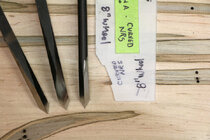
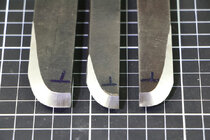
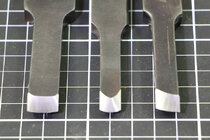
Not a video, but an article from American Woodturner Spring 2006 by Stuart Batty. You may find some answers in it. The included angle of an nrs needs to be <90° to raise a useful burr. Batty recommends 45° to 75° included angle. I use 60°, 30° top and bottom. I want equal angles top and bottom so the tool can be flipped to be used either direction.I'd be interested in a video. Actually, I think it would be interesting to see you and @John K Jordan make one together!
I am curious about bottom angles as much as top angles myself. I have three or four scrapers I think. Two of them, are relatively thick, close to half an inch. For some bowls and platters, depending on the radius of the inside, I can "run aground" with the bottom of the scraper. I've adjusted the angle on one of these two, so that gives more clearance. With a greater angle it seemed to change how it worked, which surprised me...I thought the aggressiveness of the cut would be affected by top angle (and this was not an NRS, so the top was flat), but it seemed to change things. I then reground it again so it didn't have quite the angle on teh bottom, but then I ground the lower part of it again at a much greater angle, so it has a double bevel on the bottom now. That solved my more recent issues with scraping, where I couldn't quite get into the corner of teh inside of the bowls I was working on, and it seems to behave pretty close to normally.
Still, I don't actually know any of the theory behind bottom angles on scrapers. Would be really interesting of someone taught that, as most of what I've read or watched focuses on the top angles. A video covering comprehensive theory on scrapers would be really useful.
Jon, I for many years was in the Thompson Tool booth every year selling his tools. This is the guy who makes them. He did make some of the gouges in 15V and he stated that 15V is more brittle than the 10V steel and I have seen that on a 15V tool, it has not happened to the one I have as it does not get used very often (the only time I use it is when I'm showing someone both the 10V and the 15V. I cannot tell the difference in the cut between them). The 10V steel lasts more than enough in sharpness. Plus the fact that I don't believe in the burr raising line. I'll say this again, I have seen many pros say to the crowd that the burr only lasts seconds. Then he puts it down after using it for a minute or two. Then later he picks it back up and uses it again. Most of my steel is 10V but next to my Powermatic is a rack of misc. tools, in there is a Robert Sorby 1" HSS scraper and usually I'll just pick it up and use it and it works great. It has not been sharpened in years yet it works without a problem (not a NRS). I have some HSS, some M42 and a lot of 10V steel and I have never did a test as to how long they last as I have left that for others. And there have been many of those and it stands that in terms of lasting in sharpness the ongoing conclusion is that (not including 15V) its 10V, then M42 and then HSS. Remember that when a pro tells you that what he is using is the best its because he's getting something for using them or he is selling them. You will only know for sure if it is by buying them all and finding out for yourself. And with that I will tell you that when teaching I tell the students all of that and that I tell them now days that Thompson 10V tools and Hunter carbide are the two best choices in each of those two categories in my estimation.I'm curious, since I'm in the market here. The Batty NRS system has blades made with 15V and 10V. If you were to choose one, which one would you choose? Would 10V be better, given its not quite as brittle, but should still offer longer wear resistance than M42 and certainly M4?
I agree with you that you don't have to raise the back of the handle...OR, tilt the scraper so only a corner rests on the toolrest. I've tried both, and I have less control with either. Tilting the handle up seems to make a normal scraper more...well, it seem to bite into the wood more. It may be a consequence of angles and natural forces, not sure, but I've never really had that problem with an NRS. I think that may be the key benefit of an NRS...that you get the softer less aggressive effect on the wood, with the full stability of the tool on the rest. I think that's a valuable difference.
when teaching I tell the students all of that and that I tell them now days that Thompson 10V tools and Hunter carbide are the two best choices in each of those two categories in my estimation.
Jon, I for many years was in the Thompson Tool booth every year selling his tools. This is the guy who makes them. He did make some of the gouges in 15V and he stated that 15V is more brittle than the 10V steel and I have seen that on a 15V tool, it has not happened to the one I have as it does not get used very often (the only time I use it is when I'm showing someone both the 10V and the 15V. I cannot tell the difference in the cut between them). The 10V steel lasts more than enough in sharpness. Plus the fact that I don't believe in the burr raising line. I'll say this again, I have seen many pros say to the crowd that the burr only lasts seconds. Then he puts it down after using it for a minute or two. Then later he picks it back up and uses it again. Most of my steel is 10V but next to my Powermatic is a rack of misc. tools, in there is a Robert Sorby 1" HSS scraper and usually I'll just pick it up and use it and it works great. It has not been sharpened in years yet it works without a problem (not a NRS). I have some HSS, some M42 and a lot of 10V steel and I have never did a test as to how long they last as I have left that for others. And there have been many of those and it stands that in terms of lasting in sharpness the ongoing conclusion is that (not including 15V) its 10V, then M42 and then HSS. Remember that when a pro tells you that what he is using is the best its because he's getting something for using them or he is selling them. You will only know for sure if it is by buying them all and finding out for yourself. And with that I will tell you that when teaching I tell the students all of that and that I tell them now days that Thompson 10V tools and Hunter carbide are the two best choices in each of those two categories in my estimation.
Inside/outside, my technique has worked really well for 35 years. I think I learned that from Raffan. I'm not talking about where the burr is on or above/ or below centerline of the bowl, I'm talking about making sure the burr is below the height of the centerline of the handle. BUT, most believe I never know what I'm talking about, so you've joined that club. Amazing I've earned thousands and thousands of dollars turning, and not killed myself!Unless you're working on the INSIDE of a bowl....
Richard you talk like the scraper is something nobody knows about. I myself and probably 99.5% of all turners learned that with the conventional scraper the handle must be raised and if they didn't know sticking that scraper straight in without raising the handle they found out quickly unless they were using it for roughing.Inside/outside, my technique has worked really well for 35 years. I think I learned that from Raffan. I'm not talking about where the burr is on or above/ or below centerline of the bowl, I'm talking about making sure the burr is below the height of the centerline of the handle. BUT, most believe I never know what I'm talking about, so you've joined that club. Amazing I've earned thousands and thousands of dollars turning, and not killed myself!
My thought is that the NRS using 15V would be more susceptible to chipping as there is no body beneath the edge. And if you think that the 15V gouge flexes more than a this sliver of 15V on the end of a tool well I await your thoughts when you buy that tool.So...I can imagine a GOUGE, is probably more subject to issues with brittleness, than the burr on a scraper, especially an NRS. Right? I don't think I'd choose the most brittle steel for a gouge, I think you would want a bit more flex for something that is often used quite aggressively to remove large chips of wood fast.
I turned for over 35 years before anyone "invented" the current negative rake scraper. I bought a negative rake scraper, and now it's in my misfit, unused tool drawer. Most of us used the Irish grind bowl gouge, skew, or freshly ground scraper to do fine scraping in the past. I still think a fine burr on a big scraper is a better tool. A negative rake scraper is NOT a necessity. It is a great way to spend money if that is your goal.
Well, maybe look up my video about "Scary Scrapers". Bigger and thicker scrapers are not safer. The problem with bigger scrapers, and this is mostly in the transition area of a bowl, you can get way too much cutting edge into the wood at one time, and that is what makes them "self feed" and/or catch. As for V10 and M42 HSS edge durability, I think those numbers are inflated. As near as I can tell, there is almost no difference in edge durability. This is the same metal that bimetal bandsaw blades and chain saw teeth are made from. I have a friend that had turned for 60 years and asked him about the differences between the two metals, and he said there was no difference. As for edge durability, again, the skew chisel was the first NRS. Now they are far more specialized. The most durable and long lasting, and sharpest edge you can get is a burnished burr, similar to what you do with a card scraper. I do not remove the grinder burr, just burnish it down when it gets dull, and back up again. I have found that the burr to last longer, you need some metal under it. The standard skew chisel the burr disappears in seconds, and the burr is what does the cutting.
robo hippy
Just based on my decades of teaching experience Bill. When you do a beginners class at Woodcraft, you see a lot of bad habits. I stand there and tell them what to do, they don't do it. I put my hands on the scraper along with their hands, and I have to fight their strength to keep the handle up. I go help someone else, look back, and the student has dropped the handle. People with carbide insert tools are just as bad. Somewhere they got the idea to keep the carbide on the center of the part and handle either level or slightly below the cutter. I don't consider this forum as a group of highly skilled turners. You sure don't see the big hitters every stop by, except for Lyle.Richard you talk like the scraper is something nobody knows about. I myself and probably 99.5% of all turners learned that with the conventional scraper the handle must be raised and if they didn't know sticking that scraper straight in without raising the handle they found out quickly unless they were using it for roughing.
Sorry, Did I misinterpret Paul's statement? What is the distinction between too aggressive and less aggressive? Isn't it hard to interpret what that means? Both use the word aggressive, so maybe one person's aggressive is still too aggressive for someone else? "I prefer the NRS’s over conventional scrapers. They are less aggressive"I think you’re misinterpreting the point, Richard. It’s not that the standard scraper is too aggressive. Rather, the negative rake provides a more subtle result. I default to a freshly sharpened standard scraper, but there are times when I want a more delicate scrape. That’s when the negative rake earns its keep, for me at least. This is especially true when I’m in a deeper vessel and need to hang more of the tool beyond the rest. NR scrapers are great for that IME.
I do not scrape much externally, only if the shape is really complex. Internally on HV yes ,as it can be a challenge getting the surface they way I want it. They generally egg shaped HSS with angles around 85' for fine and 20' for more material removal. I as you can rotate them, they can be negative, neutral or in shear mode. I have several different shapes and sizes with various curves, they are set up on their own shafts so I can rapidly make the change.
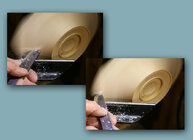
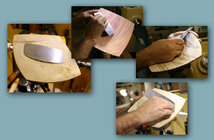
My thought is that the NRS using 15V would be more susceptible to chipping as there is no body beneath the edge. And if you think that the 15V gouge flexes more than a this sliver of 15V on the end of a tool well I await your thoughts when you buy that tool.
Its interesting not many manufacturers use 15V it seems, why is that I wonder? I/we found when using Tantung steel it was prone to chipping so we had to change the geometry to give the edge more strength, maybe this might sort out the edge problemI don't think a 15V would flex MORE. I think it would flex LESS. It is a more brittle metal. But, I kind of think that is the point? I may do things differently, but I don't find an NRS to be a tool of aggression, where chipping might occur on a regular basis. I find it to be a tool of finesse, and final cleanup. I could be wrong, I've never used 15V steel in any tool before...but, as I mentioned in my previous post, I wouldn't be using such a tool to hollow out bowls, only do light cleanup cuts to get a super fine finished surface on the inside of bowls and platters.
I'm honestly curious here, I am not trying to defy or debate needlessly. I was in my previous post as well. I am honestly wondering, if the HARDNESS of 15V, would in fact help it do a better job of the job of taking fine cleanup cuts inside of bowls/platters (or the inside of anything with that kind of blank)?
Its interesting not many manufacturers use 15V it seems, why is that I wonder? I/we found when using Tantung steel it was prone to chipping so we had to change the geometry to give the edge more strength, maybe this might sort out the edge problem
I think the main reason is the cost, quite a difference between 10V and 15V.Its interesting not many manufacturers use 15V it seems, why is that I wonder? I/we found when using Tantung steel it was prone to chipping so we had to change the geometry to give the edge more strength, maybe this might sort out the edge problem
All of these tool steels have about the same Young's Modulus (E), and will deflect essentially the same (applicable for the tool shaft extended over the tool rest. Mild carbon steel is in the same E range. Deflection of the tool shaft is a function of the size/dimensions of the shaft, not the material, and primary the dimension in the vertical axis which is resisting the cutting force.I don't think a 15V would flex MORE. I think it would flex LESS. It is a more brittle metal. But, I kind of think that is the point? I may do things differently, but I don't find an NRS to be a tool of aggression, where chipping might occur on a regular basis. I find it to be a tool of finesse, and final cleanup. I could be wrong, I've never used 15V steel in any tool before...but, as I mentioned in my previous post, I wouldn't be using such a tool to hollow out bowls, only do light cleanup cuts to get a super fine finished surface on the inside of bowls and platters.
I'm honestly curious here, I am not trying to defy or debate needlessly. I was in my previous post as well. I am honestly wondering, if the HARDNESS of 15V, would in fact help it do a better job of the job of taking fine cleanup cuts inside of bowls/platters (or the inside of anything with that kind of blank)?
